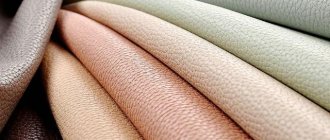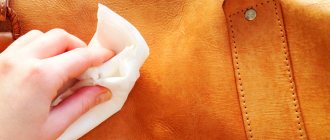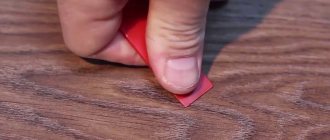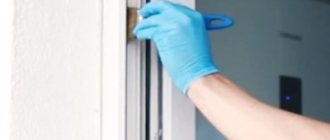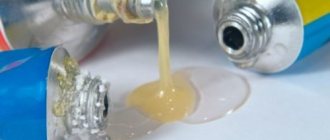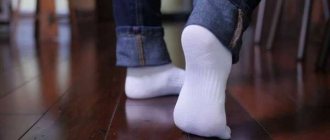Genuine leather has always attracted the attention of consumers, both men and women. Leather gloves, shoes and bags are considered the standard of quality, comfort and style.
However, today there are many options for leatherette for those who do not want to wear leather products due to ethical principles or high price. Thus, a fairly large part of buyers, for these or other reasons, choose leatherette products. These materials have a similar appearance, and are often of very high quality.
With the advent of leatherette on the textile market, low-quality goods also appeared. Some companies deliberately hide the fact that they make things from artificial leather and present them in stores at the price of genuine leather products. Also, some fakes can be made from natural raw materials with the addition of leatherette. And in this case, such goods should cost less. However, manufacturers keep hidden details and charge high prices for their products.
Types of substitutes
Before we tell you how to find out and check whether it is leather or leatherette in front of you, let’s consider what imitation materials actually are.
They usually consist of several layers - knitted, non-woven, polymer and impregnation between them. The analogue is afraid of water, frost-resistant, sometimes deforms when bent, and is relatively inexpensive. Among the most popular options:
- Dermantin is good for its cheap price, wears out for a long time, is heat-resistant, and has a low odor.
- Vinyl leather – realistically imitates natural texture, stretches, and is suitable for draping.
- Eco-leather is elastic, airtight, does not crack even at low temperatures, and does not smell.
What is eco leather?
Artificial leather is a polymer film coating applied to knitted, fabric or non-woven fabric. Until recently, the most common polymer was polyvinyl chloride (PVC), the top layer of which was not breathable.
Eco-leather is a high-tech material; what distinguishes it from its predecessors is that it is breathable and made without the use of PVC. The film on it is formed by polyurethane. During operation, no harmful substances are released from the polymer film; it is environmentally friendly. It is literally penetrated by micropores, so eco-leather allows air and water vapor to pass through, but does not allow water to pass through.
The breathability of eco-leather is many times higher than that of genuine leather.
Eco-leather is warm to the touch; unlike natural leather, it is hypoallergenic. All in all, there are enough reasons to choose it. But if you prefer natural material, be prepared to carefully examine your purchase.
How to distinguish leather from a substitute and check its naturalness
There are several important guidelines - pay attention to the following properties of the thing and what it is made of:
- Price – an accessory made from natural raw materials, especially a branded one, always costs a significant amount. In pursuit of cheapness, the risk of buying a fake increases.
- The presence of a manufacturer’s logo or the embossed name of a famous brand is an excellent confirmation of originality.
- Elasticity – Press down on the outer wall of the bag with your finger. The material of natural origin will develop small wrinkles when pressed, but will quickly straighten out, but the dent will remain on the same dermantine.
- Heat transfer - if you don’t know how to distinguish real leather from artificial leather right in the store, pinch it with your fingers directly upon purchase and wait until its surface heats up from your hand. At the same time, natural leather will remain dry, leatherette will sweat and cool quickly (literally in a matter of seconds).
- The texture of the edge edge is uniform in eco- or vinyl leather, while in varnish or shagreen leather it is rough. Therefore, the section in the first case shows a textile base, in the second - a lot of fibers.
- Resistance to deformation - try bending (twisting) the accessory. Dermantin will crack at the bend and/or may change color; this certainly will not happen with natural material.
Also pay attention to the overall neatness of the bag. Uneven seams or cheap-looking lining fabric should immediately raise red flags.
These were mainly visual methods, which are good for directly choosing a thing. Now let's see how to recognize genuine leather and distinguish it from artificial fakes at home. Below are several ways.
Trial by Fire
Arm yourself with a lighter and bring the flame to the surface of the accessory. This is not terrible for a material of natural origin, but leatherette will at least melt. The smell is possible in both cases, but in the second you will feel a not entirely pleasant aroma.
Reaction to water
Just drop a little liquid on the item and see what happens. If the wall of the bag begins to gradually absorb moisture, darkening, it means that this is not an imitation, because drops would flow down the same dermantine.
It would seem that water resistance is a good property, but paired with air tightness it leads to a greenhouse effect.
Tactile check
When you don’t know how to identify real leather and distinguish it from artificial leather, pinch the fabric of the bag between your fingers. If it quickly warms up, but remains dry and pleasant to the touch, then you have a natural material in your hand; if it has become sticky, it’s a fake.
To be sure, perform the following test for elasticity and softness:
- Bend (squeeze) the wall of the accessory, press your finger on its outer surface.
- Hold for a few seconds, then release and see what happens.
Raw materials of natural origin will flexibly return to their original state, without a single fold or wrinkle, but creases will remain on the same dermantine. Over time, such bends will turn into cracks that will hopelessly ruin the item.
Specific smell
The noticeable difference between natural leather and artificial leather (leatherette) lies precisely in the aroma. If in the first case it is weakly expressed and rather noble, then in the second it is harsh, chemical, unpleasant, hitting the nose. But in order not to be misled, you don’t need to focus only on the smell.
Piece of cloth
This is a sample attached to a tag. The manufacturer is obliged to make it in the form of a stretched skin in the shape of a diamond. Manufacturers of leatherette products often ignore this rule.
Inscriptions
Look at what the ingredients say on the label. Depending on the country of production, the following words speak about naturalness in different languages: genuine leather (English), echtleder (German), cuir (French), vera pelle (Italian).
Checking the right size
This is most relevant when you are choosing a belt for another person, for example, as a gift. In other cases, this accessory is easy to try on even if there is no fitting room in the store.
On average, the belt should be 5-15 centimeters longer than the waistband of the trousers of the person who will wear it. The holes on the PShM belts are punched based on the length of the free end - 15 cm.
If possible, measure an old belt that is exactly the right size and select a new one of similar length.
Classic trouser belts have a width of 2.5-3.8 cm. Casual ones (for jeans, etc.) are usually wider than formal trouser belts - 3.8-4.5 cm. In our line, the average width of men's trouser belts is 30-35 mm, everyday - 35-45-50 mm, and women's models - 25 mm.
How to distinguish leather from leatherette
Here are some more ways to determine:
- Grasp the side of the bag with both hands and gently pull it in different directions. An artificial material will show its elasticity strictly evenly, a natural one will stretch smoothly, but not equally. To be sure, you can then press on the place of inspection: the imitation will easily yield to pressure and will retain the dent for a long time, the original will resist and quickly return to the original smoothness of the surface.
- Look at the pattern and nature of the pores. In dermantine they are at the same distance in relation to each other, having the same shape and size. This is not observed in the skin, after any processing. It has different structure and pattern depth.
- Pay attention to the color of the item. Made from artificial raw materials, it can amaze with the brightness and richness of its shades. This is explained by the fact that non-natural fabrics absorb paint better.
Testing with water
Another way is to drip a few drops of liquid onto the surface. Natural matter will immediately absorb it, leaving a characteristic dark spot. Synthetic analogues will repel it, but the color of the surface will not change in any way. But you shouldn’t rely too much on this method. Modern things, especially expensive ones, have long been treated with water-repellent mixtures in order to increase wear resistance and ease of use.
Leather bag or not
This is the thing you always take with you. Moreover, while wearing it, it may get exposed to rain or snow. After all the adventures, it must maintain its aesthetic appearance: remain attractive in a new way, not become cracked or wrinkled. This will not happen if the accessory is made from a material of natural origin.
You don't even have to subject the bag to numerous tests - just study the information (and graphics) presented on its label. This is a small sticker on which it is written what the top, lining, and decorative elements are made of. Any self-respecting manufacturer is obliged to indicate this data, and if it is not there, this is a fake.
Material structure
If you have any doubts, be sure to feel the accessory, both outside and inside. From the inside out, natural raw materials are always fleecy, while artificial ones are usually smooth. There should also be a light fluff on the front side, so that after contact with the palm, the shade of the suede or shagreen surface should change slightly.
Another method that tells you how to identify natural leather and distinguish it from artificial leather (leatherette), and is related to the structure, is simple weighing. The same dermantine is much lighter than skin, and you will see the difference on such a relatively small object as a bag.
Appearance and cuts
- Evaluate the edges and folds of the item. For a material of natural origin, they will most likely be thick and rounded, while for an imitation material they will likely be relatively thin and flattened.
- Check the inside again, but this time paying attention to the structure. A textile base without fibers is a sure sign of a fake.
- Look how well the seams are made - a self-respecting brand carefully hides all the cuts, not to mention the craftsmen of design houses.
Let's summarize what genuine leather looks like. It can be smooth or fleecy, but it always remains grainy, with a chaotic pattern and different pore sizes. Its color is even and quite rich, but not overly bright even after the most intense dyeing. Its shade does not change at the edges and folds.
The Piquadro online store offers only natural leather bags, suitcases and accessories, which are of high quality, long service life and durability.
In the article you learned how and how artificial leather differs from natural leather. Check products carefully and beware of counterfeits.
Special attention should be paid to suede
It is suede products that can most often be found on the market after ordinary leather ones. Often, several types of leather are combined in bags, shoes, wallets and clothing. Suede or varnish pieces are inserted. Chamois is the raw skins of deer, elk, sheep and young calves, richly soaked in fat. It is counterfeited using several methods: woven and non-woven. The first is special processing of microfiber threads under production conditions. The second is the usual gluing of pile on top of a textile flap. To distinguish suede from a fake, you need to:
- Estimate the cost. Suede products cannot be cheap. They are not for the wallet of a budget buyer, even with the maximum discount.
- Take the accessory in your palm and feel it. Natural matter quickly heats up and takes on the temperature of your body, and itself begins to radiate heat. Pseudo-suede will remain cold.
- The pile can be “combed” in any direction with the palm of your hand. The shade of the surface will change. The counterfeit hairs do not react to such manipulations and their color will remain the same.
- If the item is uniform in tone and texture, you are probably getting a fake. Natural suede will always have microdamages, scratches and cracks.
- The leather is elastic; if you bend it in half, a trace of a crease will appear, which quickly disappears, and the surface will return to its original appearance. With a fake it will be different - either the trace will not go anywhere, or it will not form at all.
Reviews
Anna, 32 years old
I just love leather things! Over the years of wearing them, I have already learned to distinguish real material from artificial material by touch - it is really more natural and natural, resilient and elastic, immediately restores its shape and really heats up in the palm. It is difficult to tangle, especially if you squeeze it with your fingers and rub it lightly. So I can advise you to focus specifically on your tactile sensations, and determining by smell is risky - it is increasingly being counterfeited.
Dmitry, 26 years old
I was planning to buy a bag for my wife for her birthday, and I came across your article just in time. So many useful things. Previously, the only testing method I knew was ignition, but it’s clear that sellers will never agree to such tests. Now I know what to look for, where to feel, where to press - thank you.
Gustatory and olfactory factors.
Another quite popular and reliable test is smell and even taste. However, today this method is becoming less and less reliable, as when working with natural leather, more and more levels of processing are used, which can eliminate the natural taste and smell of the material altogether. In turn, a very large number of additives have already been developed for leatherette, the smell and taste of which can mislead even professionals.
How can you recognize a leather or leatherette belt if it is on display behind glass?
Belt color. Many belts, both genuine leather and leatherette, undergo a dyeing process. Due to its physical and chemical properties, the natural material will have a uniform color (unless the opposite was intended by the designer and manufacturer). In the case of an artificial analogue, there is a high probability of having lighter or darker areas, but this does not always happen.
Product quality. As a rule, manufacturers working with genuine leather perform quite high-quality processing, riveting and other types of work when creating a belt, and as was written at the beginning of the article, leather products are highly wear-resistant. Thus, if you find protruding threads or any fastening element is poorly secured, then this is an indirect sign of leatherette material.
In the end, it is worth noting that there is no universal and 100% method, and it is really possible to reliably find out whether the belt is made of genuine leather or leatherette, only using several verification methods.
Our work - belt models
Tags: how to determine whether a leather belt is or not, how to distinguish a leather belt from a non-leather one, how to check whether a leather belt is or not, how to tell if a leather belt is or not, product quality

